We’ve painted over 2,000 homes and choosing the right amount of paint is still tricky. Paint is expensive and you don’t want to overbuy (paint stores will not refund an already tinted gallon of paint).
We recommend only buying about 80% of the estimated paint you need at first and then buying the remainder when you’re almost finished. This keeps you from overbuying paint.
However, sometimes you don’t have time to make 2 trips to the paint store and you have to take a leap of faith. This guide will help you decide how much paint you need:
Exterior House Paint
| House Size | Body | Trim | Total Gallons |
| 1500 sq ft. | 8 | 2 | 10 |
| 2500 sq ft. | 12 | 3 | 15 |
| 3500 sq ft. | 15 | 4 | 19 |
| 5000 sq ft. | 20 | 7 | 27 |
Interior House Paint
You’ll use more interior paint in general because there is much more surface area inside a house than outside.
| House Size | Body/Walls | Trim/Baseboards | Total Gallons |
| 1500 sq ft. | 12 | 3 | 15 |
| 2500 sq ft. | 18 | 4 | 22 |
| 3500 sq ft. | 25 | 6 | 31 |
| 5000 sq ft. | 35 | 8 | 43 |
Factors that can DOUBLE how much paint you need:
1. Surface type
A rough surface can double the amount of paint you need. Examples of rough surfaces:
Shingle/Shake Siding

Stucco Siding
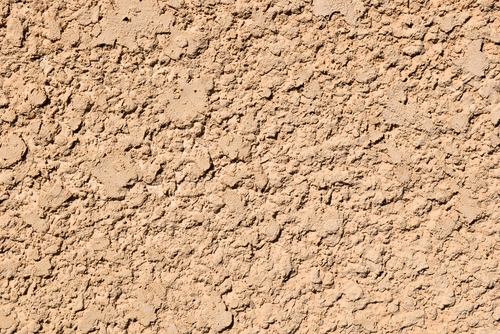
Brick
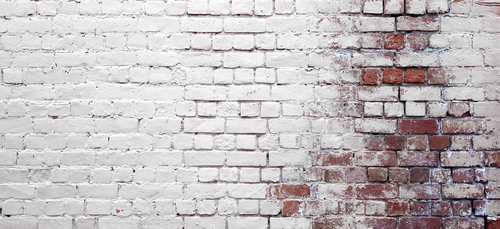
2. How many coats?
If you want two coats on a house, you’ll need about 1.5x as much paint. Many people assume you’ll need twice as much paint, but since the first coat actually covers many porous areas that would normally soak up paint, the second coat uses far less paint.
3. Drastic change in colors?
Going from light to dark can really affect how much paint you need. It can sometimes take 2-3 coats to cover a much different color.
If your old colors and new colors are on opposite sides of a color wheel, you’ll need more paint.
4. Quality of paint
The quality of paint affects how much you need also. Higher-quality, expensive paints generally cover much better than cheaper paints. This is because cheaper paints have less resin (the main component that holds paint together).
Actual Houses We Painted and How Much Paint We Used
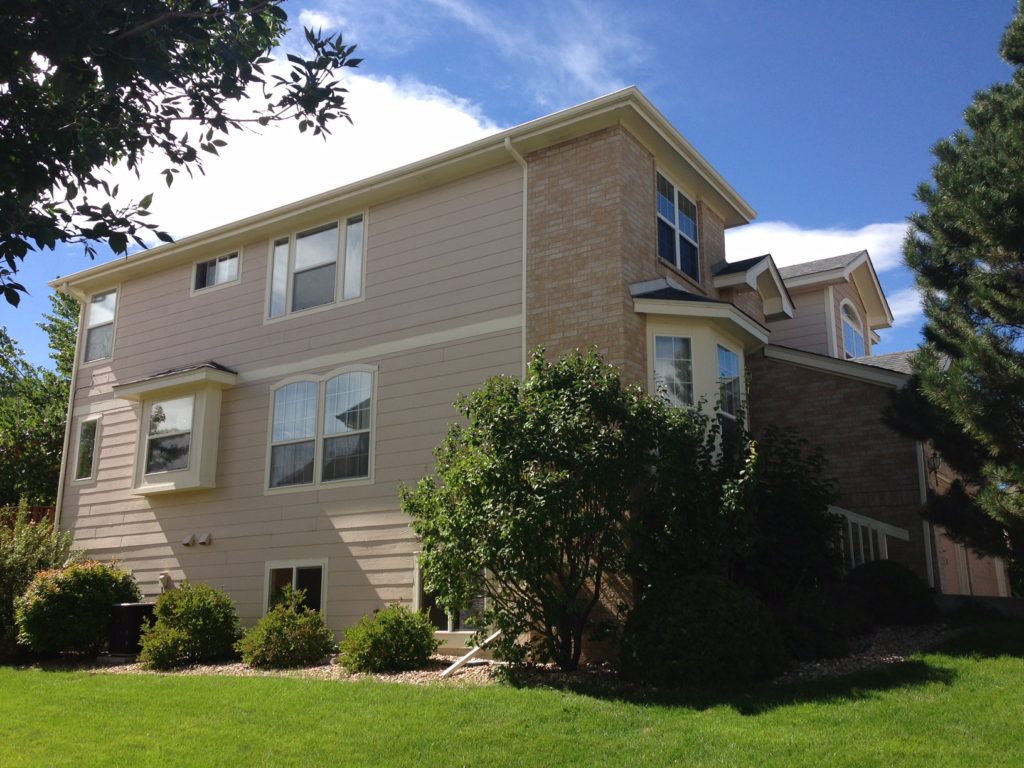
Gallons of Body: 15
Gallons of Trim: 3
Total: 18
Factors: This house was pretty big, but it was about 30% brick, so we didn’t need as much paint.
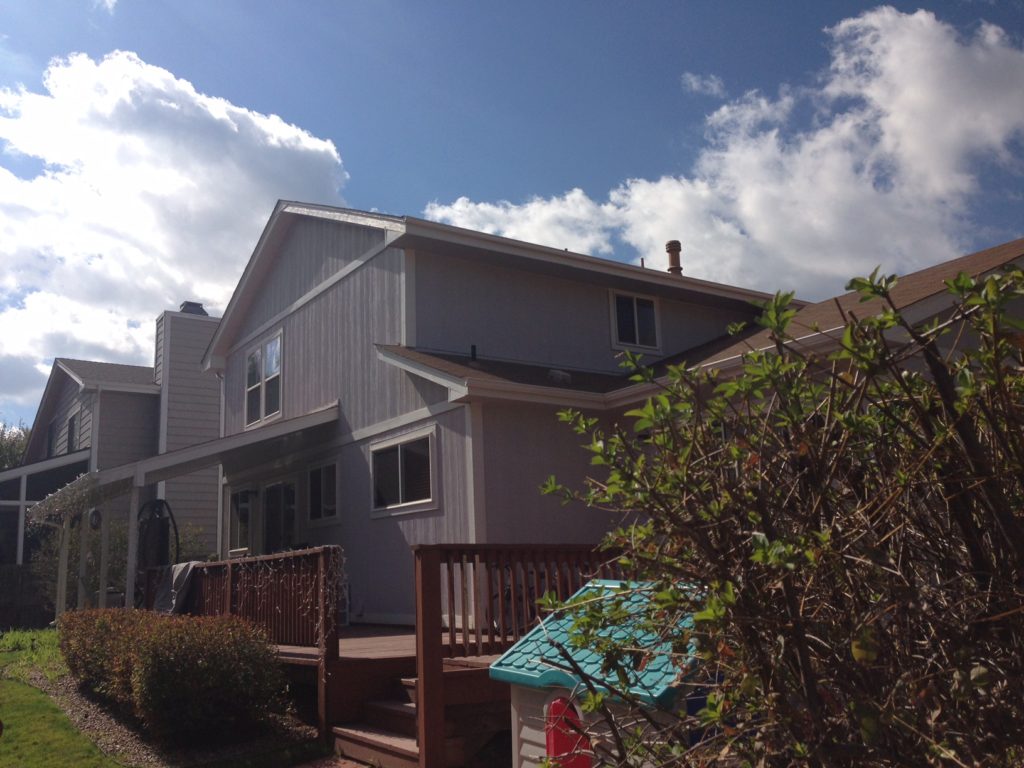
Gallons of Body: 12
Gallons of Trim: 2
Total: 14
Factors: Smaller to Medium-sized house but the wood was in rough shape so it used more paint.
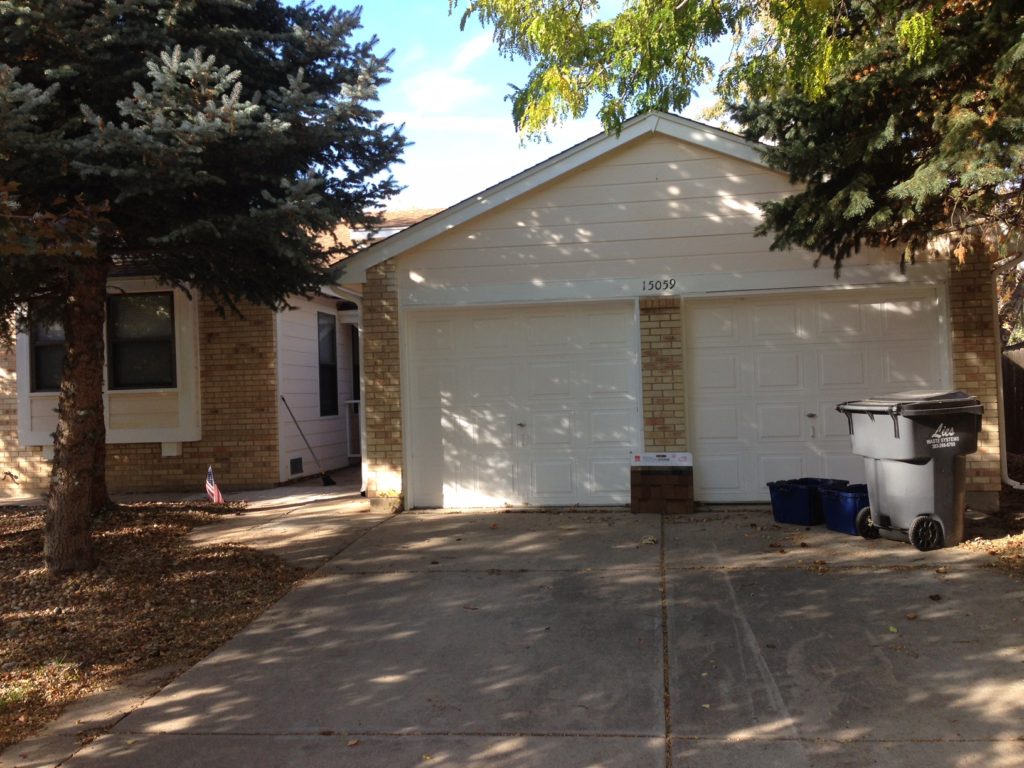
Gallons of Body: 8
Gallons of Trim: 2
Total: 10
Factors: Smaller house that was about 30% brick.
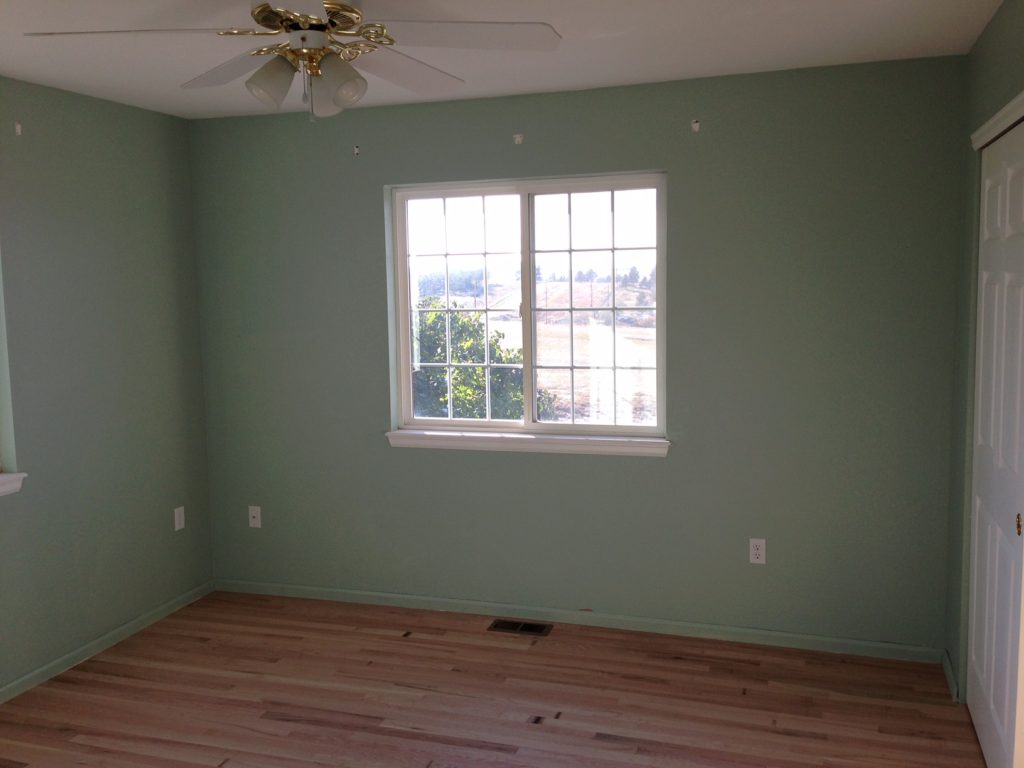
Gallons of Body: 1.5
Gallons of Trim: .5
Total: 2.5
Factors: This room took 2 gallons total. A small bedroom like this usually takes no more than 1.5 gallons and then a half a gallon for the door and baseboards. The walls had a smooth surfaces as well (which uses less paint).
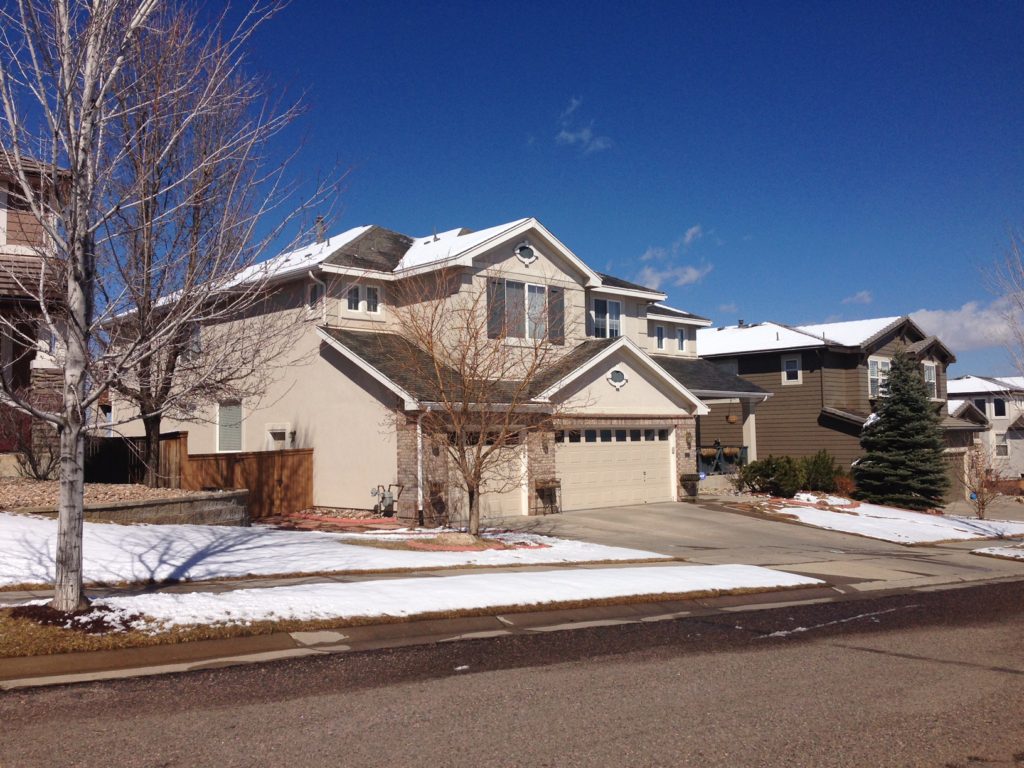
Gallons of Body: 16
Gallons of Trim: 3
Total: 19
Factors: This house was bigger and half of it was stucco.
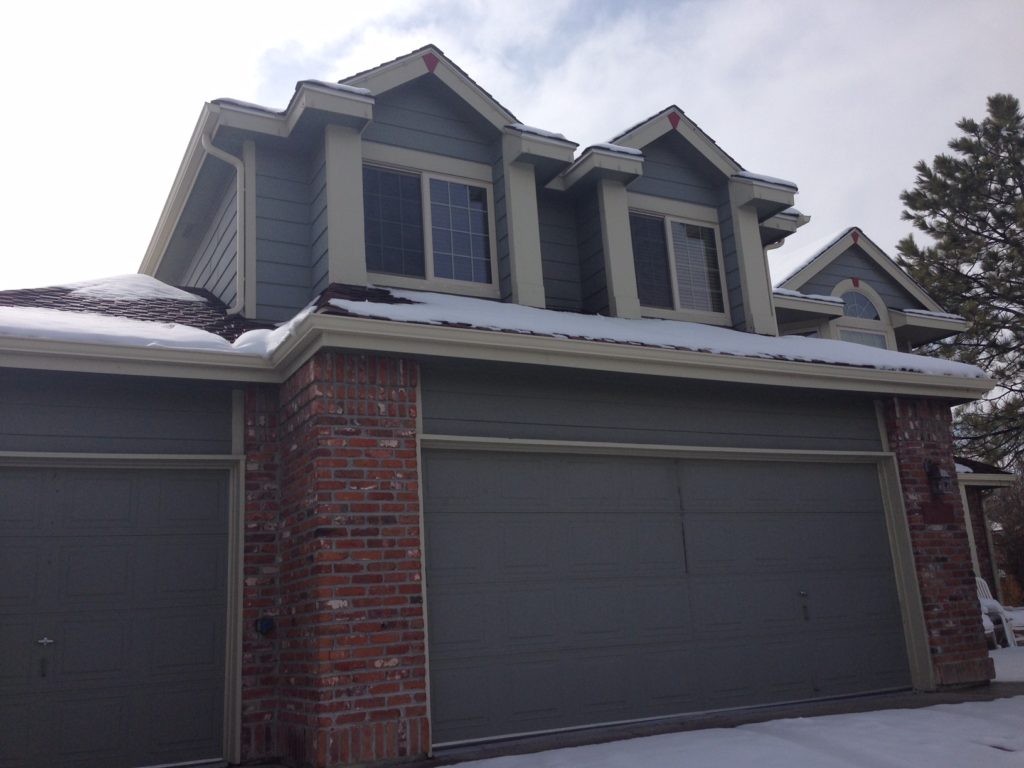
Gallons of Body: 24
Gallons of Trim: 5
Accent Gallons: 1
Total: 30
Factors: This house took a lot of paint, mainly because we went from a light beige to the dark green in the photo. Big house + serious color change + lots of trim = a lot of paint.
Secrets to Using Less Paint and Saving Money
1. Replace Spray-Tips Periodically
An old spray tip uses much more paint than a brand new one. Once the tip wears out, the fan of the spray starts to blot in the center of where you’re spraying. This uses way more paint directly where you are spraying and leaves a weak, uneven coat on the edges of the spray fan.
2. Use a Quality Paint for Big Color Changes
We covered this a little earlier, but a drastic color change means you’ll need more paint. However, if you use a high quality paint sometimes you can get by with only 1 coat, which actually saves the total paint needed. You’ll still spend more on the paint, but you’ll save money on the labor side and your home will be better protected.
3. Bend Your Wrist as You Spray
It’s important to always be moving your arm/wrist when you’re spraying a house. Ideally you always want to be about 12-18 inches away from the siding at all times. Many people pull their arm away at the last part of the sweep, creating an uneven spray job and paint buildup in the middle.
4. Use Rollers Instead of Spraying
We get this question all the time: ‘Is it better to spray or roll your house?’ The answer is: it depends on what you want. Rolling a house uses less paint but actually covers the siding and trim better. Spraying doesn’t quite push paint into every crack like rolling does, but you’ll save a lot of money on labor, as rolling can take twice as long. You also get more protective paint on the house when you spray. So there is no clear answer on which is better, it just depends on what you’re looking for.
5. Only Buy 80% of What You Think You Need
Once you estimate how much paint you need, only buy 80% of that. When your closer to finishing, you’ll have a clearer idea how much you need left. This saves you from buying too much paint.
We hope this guide helped you. Now you can accurately estimate how much paint you need on a wide array of homes. Thanks for reading!

37 Comments
Thanks for your e-mail and for the information shared, I appreciate painter choice, looking forward to more guidance from you. We are a new company, just starting, and will be needing more info from you.
i want know how much money should be invested in a paint business. let me know in detail. can u help me?
Hello, we have a cost breakdown of what it takes to start a painting company here.
in the above pics of homes, it does not say the cost of primer. does the total gallons include primer? all you say is it took 12 gallons of paint to paint this house. ok so, how much of that is primer? did you use primer?
Hi Tim, these estimates are for paint only. We always use primer, sometimes 1 gallon, sometimes 10-15 gallons if we’re priming the whole house first.
Hi I am planning on trying to paint the exterior of my house myself. The current color is that beige brown tan color you see in most subdivisions. We are thinking of going with a light yellow color probably 2 coats. should we use a white primer on the house first so the old color does not bleed through and if so does that need multiple coats also?
Hi Terry, using a lighter primer is a good way to get a richer (non transparent) color. Especially if you’re doing very different colors, which you are. That’s actually how many pro painters do it. You can even ask to tint the primer to the light yellow color so it covers even better.
If your house is already painted, do you need to prime it?
Hi Linda, you don’t need to, but priming always helps. The new paint will stick better if you prime first. It will also add more protection in general.
Hi there! My 13 y/o house needs its first ever re-paint. Currently very dark blue (midnight) w/tan trim. Siding is hardy plank. Paint in good shape in 80% of surface area, but in some places on the front of the house (most sun exposure) the paint is almost copper in color now. Want to repaint close to original color, but 4 questions: 1-what causes that, 2- how do we prevent it going forward, 3- should we do two coats, and 4- how many times can you repaint hardy plank before it has to be scraped and you start over? Thanks so much!!
Hi Chandler,
This is my first read of your material. Very informative, but I do have one issue: After reading all your suggestions, you say, “Now you can accurately estimate how much paint you need…”, but there is no formula so that each of us can accurately estimate our paint amount. My house is 1354 square feet…how do I compute how many gallons for a specific area? Going on the 1500 sq ft you used is not close enough for me, as I would buy too much paint using that as a guide.
Hi Lana, generally exterior paint covers 150-200 sq ft. (depending on the surface). More coarse surfaces require more paint. So to use your example of 1354 sq. ft. I would buy 1 less gallon of body color, so 7 gallons body and 2 gallons trim. Also, It’s a good practice to buy about 80% of what you think you need, that way you’re not overbuying. You can always go back and get a couple extra gallons if needed, but you can’t return paint that’s already been tinted. Hope this helps, thanks!
Paint can cost from $15 to $80 a gallon depending on the brand, your discount and the quality. Contractors typically pay up to $45 per gallon, according to Painting Leads .
Is paint +primer a good paint to use for interior spaces? I’m going from a tan color to a light gray. Also which low voc paint offers the best coverage in a satin interior paint? This will be my first paint attempt so any tips will be greatly appreciated!!
Thanks
Hi your estimate is quite spot on!
I painted an approx 2200 sqft townhouse’s walls only an I needed 12 gallons of paint.
I was wondering if you have advise on how much paint for ceilings based on Square footage of homes. You had estimates for Walls and Trim, but not ceilings.
If you’re just doing raw square footage, like your example (just ceilings), the formula is basically 1 gallon per 150-200 sq ft. So you can just measure the square footage of the ceilings and buy paint accordingly. Again, this can vary drastically if you’re doing straight white ceilings (this sometimes takes 2-4 coats), or if you’re changing colors drastically.
Do all your guides above consider only one coat? Times 1.5 if you double coat body/walls and Trim/baseboard? Does your above estimates for trim and baseboard take into account interior doors?
Hi Caleb, yes one coat. And then multiply by 1.5/1.75 for two coats. Yes, above estimate accounts for all interior items; trim, baseboards, doors etc.
Good afternoon,
Planning on changing the color of a 2500 sq ft brick home from red brick to white. Should I pressure wash first prior? And also how many coats approximately do you think it should take? the home also has a metal roof that I plan on changing the color from rusty red to navy blue, any suggestions?
Hi April, you should always pressure wash before painting. Brick is more porous so it will take more paint than usual..and white doesn’t cover red very well..so I’d anticipate at least 2 to 3 coats. I’d also recommend back-rolling over the prick if you’re going to spray it.
I was wanting to paint the outside of my 10 x 54’ mobile home and I was wondering how much paint I try would take?
I’m looking at painting my exterior and was wondering if outside temp is a factor? It’s currently July and not sure if the high temps make a difference. Sherwin Williams told me that it’s doesn’t matter cause it just dries a little faster. Not sure if this is true?
Hi Rick, in our experience it doesn’t matter if it gets too hot, it just makes it more difficult to apply from the painters standpoint. Super hot days will make the paint thinner and run/drip a little more. The main thing to worry about is painting when it’s too cold (I think they say never paint below 38 degrees farenheit).
Thanks for this info.
Maybe a typo but under “interior house paint” did you mean ceiling/walls instead of body/walls?
It should say body/walls/ceilings, sorry about that
How can I tell what paint is on my house already before I buy, can I put acrylic latex over whatever’s on now?
Water based paint can go over just about any coating besides stain. If you put it over stain it will peel, if it is a stain then you will have to strip it, prime then paint. They do have a tester to see if it is a lead based paint but odds are it isn’t unless it’s an extremely old home.
Hi, my house is 1500sqft.. It’s include 3 bed rooms, one living room, kitchen and pantry…. How many litter /gallon paint required for renovation??
We have about 2k Sq ft home going from dark to light, thinking of needing about 10 to 15 gallons of primer and about 20 gallons of paint (2 coats), does that sound about right? Is it better to buy in 5 gallon increments too?
I never know if you use wall area or sq footage of home on figuring cost?
I have a cape cod house, 1400 sq. ft. It’s white with black trim on wood shingle siding, and the old paint is chipping. do I need to power wash before painting? How much paint and primer will I need? And would I need more or less if I painted with a roller versus a sprayer?
Thanks! Your guidance is appreciated.
You can power was your home to prep it but it will take 5-7 days or more to completely dry. If you apply a primer coat or topcoat while there is too much water on the wood, it will peel from the water. Or you can peel the loose stuff off and scuff the surface. The already painted areas you can paint over without priming. If you are drastically changing the black trim color then prime it and topcoat with a minimum of 2 coats. The amount of paint depends on the total sqft of the exterior and trim size. A gallon will go 350-400 sqft so once measured just divide the total amount by 400.
Painting a 1477 sq ft New Orleans house from red to a pale aqua. Thinking of roller vs. Sprayer because of close neighbors. Thinking 1 coat primer 1 coat paint plus white trim. Does that make sense and house much primer and paint do I need consider drastic color change?
How long does it take to prime and paint two coats on a 2500 sq ft exterior home?
Seller painted back and both sides of my home. It is a 1100 sq ft single level. Only need to paint the front of the house, which is also about 40 percent brick (brick on the bottom 4 feet of house). plus the front door, garage door, and about 5 windows. how many gallons do you think I will need for such little surface area? Luckily the seller left me with the paint bucket so I can get a good match.
Would it be best to spray I assume?
Also thinking about staining the brick but not sure if I will do it all at once. (any tips on that is super appreciated)
Anything else I am not thinking of??
Is there a ballpark estimate for having a crew do this? I expect I will have to do it myself to save the money I dont have.
Thanks!
Do you suggest priming new, already primed siding that will sit all winter? It’s the LP siding, so it has a tan primer on it, but we wonder if we should double up.